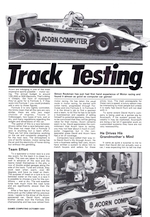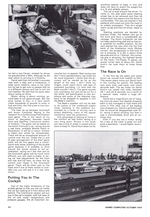
Games Computing
 1st October 1984
1st October 1984
Author: Simon Rockman
Published in Games Computing #10
Simon Rockman has just had first hand experience of Motor racing and found it almost as good as computer car games!
Track Testing
Acorn are indulging in one of the most expensive sports possible - motor racing. The annual budget is around 100,000 or 500 Electrons. That's doing it cheaply, the form of motorsport they've gone for is Formula 3; if they were into Formula 1 you could probably add a zero to those figures.
Formula 3 is very tightly controlled, the limits mean that all the cars are very similar, there are only two major choices of engines, Toyota or Volkswagen, two types of tyre, wet or dry, and many regulations regarding the weight and dimensions of the car.
The upshot of this is a race between drivers rather than a race between cars. This does not mean that a Formula 3 race is anything but a team effort. There are full time mechanics working on the car and constantly preparing it for the next race. The atmosphere is one of terrific tension, motor racing has the air and the electricity of horse racing but without the gambling.
Team Effort
To a spectator a motor race is a one day event, for the team it is closer to a week. The cars are taken to the circuit well in advance of the race and the teams install themselves in the pits, a row of double ended garages along the side of the track. Tyres are critical, they work best when warm, over 80 degrees, and have no tread on them. The purpose of tread on a tyre is to cut between water on the road, in a race it is possible to choose a tyre for the conditions - wet or dry. The wet weather tyres look much more like road tyres and are significantly slower than the slicks.
After a few laps of the track the hot slicks pick up the rubber left by previous races. I spoke to the driver of the Acorn-sponsored car, David Hunt, whose brother James won the Formula One championship and has now retired from motor racing. He has taken the usual route in motor racing; he started with junior karts, progressed through Formulas and into Formula 3. In Formula 3, it is the driver's job to find a sponsor and a team, to do this he has to be both a businessman and capable of selling himself to potential sponsors, they have to be convinced that they will be getting value for their money, Acorn certainly seem to be. David appreciates the commitment that Acorn have to racing, you may not hear about it much in computer magazines but in the non-specialist press David and Acorn have had a lot of coverage.
Computers have sidled their way into David Hunt's life through Acorn. He runs a business selling fast cars, Acorn have written a system to allow him to match buyers and sellers for these pricey toys. The main prerequisite for these cars is speed, a luxury saloon may be interesting to most people but unless it is really fast David Hunt will not deal with it.
To some extent David Hunt's company is being used as a guinea pig by Acornsoft, if his system proves successful it may be marketed. Acornsoft are doing a fair bit if specialist work on customised systems they have are not very newsworthy.
He Drives His Grandmother's Mini!
It came as quite a surprise to me to learn that David did not actually own a car, I was expecting him to tell me that he had a rare Ferrari, instead he drives his grandmother's Mini, although he did later admit to arriving in a Porsche.
David said that his brother's success was both a help and a hinderance, it adds some celebrity value to his name but he has to get over to people that he is a different person and has to win his own battles. He said that he rarely talks about racing at home.
Motor racing is about winning, second best is not good enough. But the prize money is tiny, in a race which costs thousands of pounds to enter in fuel and time, the first prize is two hundred pounds.
The main tie up between Acornsoft and Acorn Computer Racing is the research for a forthcoming Pole Position type game. This is the result of my hours of discussion between David Hunt and Geoffrey Crammond (author of Aviator). The game will be based on the Acorn Formula 3 car, racing around a real track, probably Brands Hatch or Silverstone. It will be in colour. Aviator is black and white for smoothness.
There will be an exceptional amount of control over the car. Unlike the Lo and Hi gear arrangement of the Atari game there will be five gears and a clutch. David was rather scathing of the arcade game because it is possible to drive around the whole course at full acceleration, racing isn't like that and so the Acornsoft game will be much more difficult, you will need to brake. A racing car has adjustments for the front and rear anti-roll bars, so there will be control over these in the Acornsoft game. There will be other cars on the track and if one of them wants to overtake you you will see it in a rear view mirror.
Putting You In The Cockpit
One of the major limitations of the arcade games is that you are not inside the car but looking at it from above and behind. The Crammond version will put you in the car's cockpit, with full view of the oil and water temperature and pressure gauges, the all important rev counter but no speedo. Real racing cars don't have speedometers, lap times are far more important. I doubt that the accuracy will be carried as far as the length of the race, I don't think my fingers could stand thirty odd laps of keyboard pounding, I'm sure that the Beeb wouldn't like it. The game sounds very promising, but will not be out for a fair while, the specification is very ambitious and some of the features may have to be dropped to squeeze it into the Beeb's memory.
The Beeb's speaker will not be able to do justice to the unsilenced engine noise, standing in the paddock surrounded by a horde of revving cars is simply deafening, many of the regular mechanics wear ear protectors.
One advantage of playing at home is the comfort as real motor racing is a very tiring sport. Drivers in hot races can lose a litre of water in sweat and so have to keep fit. David Hunt does not do anything special to keep in trim and does not have to watch his weight but is a fit and athletic person.
The car is built around the driver. To climb in, the side plate sized steering wheel has to be removed and then be locked back into place once the driver is comfortable. The cars are started in the paddock and crawl out onto the track in an orderly procession. They do a single warm up lap and then sit tense, ready to race.
Starting positions are decided by practice times, the fastest cars go to the front and have a considerable advantage. The Acorn Computer car had not been performing well and so had only qualified for twelfth position. As the race started the cars shot into the first bend of the Snetterton track (Riches corner), the acceleration in this kind of car is amazing, 0 to 60 in about three seconds and on to 130mph, the cornering grip is stunning, the tightest bends on the track, The Esses. A saloon car would corner here at about 40, David Hunt's car took them at three times that.
The Race Is On
In the first lap the green and white Acorn car moved from twelfth to fifth. This seven place move put David Hunt in the running for points, the leading cars were soon well away with many seconds lead. The lap times for David Hunt's car varied very little, between 26.1 and 26.9 seconds, but a tenth of a second really makes a huge difference.
David did a magnificent job of hanging onto his place and despite dropping back to 6th managed to hold there and come in fifth after one of the leading cars dropped out. David's girlfriend said that he would be disappointed with fifth, racing is about winning, but then it was a commendable drive and an exciting race.
Even if you are not a motor racing fan a day at the track is great fun and quite a spectacle. I would highly recommend it.
This article was converted to a web page from the following pages of Games Computing #10.



